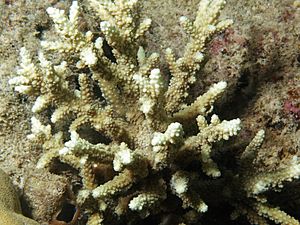Acropora horrida facts for kids
Quick facts for kids Acropora horrida |
|
|---|---|
 |
|
| Conservation status | |
| Scientific classification | |
| Synonyms | |
|
List
|
Acropora horrida is a type of coral that lives in the ocean. It was first described by a scientist named James Dwight Dana in 1846.
You can find this coral in warm, shallow ocean reefs. It often grows near "fringing reefs," which are reefs close to the shore. It likes water that is a bit cloudy, at depths of about 5 to 20 meters (16 to 65 feet).
Acropora horrida is considered a vulnerable species. This means its population is decreasing, and it needs protection. It's not super common, but it can be found over a large area. It is also listed under CITES Appendix II, which is an international agreement to protect certain plants and animals.
Contents
About Acropora horrida
Acropora horrida corals grow in groups called colonies. These colonies usually have an open, branching shape.
What it Looks Like
This coral can be many colors, like light blue, dark blue, light yellow, or brown. The tiny animals that make up the coral, called polyps, are often white or pale blue.
The main branches of the coral look a bit messy in cloudy water. But in clear water, the branches are short, making the coral look spiky. The small cups where the polyps live are called corallites. They are rough and placed unevenly on the branches. You can often see the polyps' tentacles sticking out during the day.
Where it Lives
Acropora horrida lives in warm, shallow ocean reefs. It prefers water that is a bit cloudy, especially near fringing reefs. You can also find it in shallow lagoons and on sandy slopes. It usually lives between 5 and 20 meters (16 to 65 feet) deep.
Scientists believe this coral can live for more than ten years. It becomes mature and can reproduce when it's between three and eight years old. Like other corals, it's made of a hard, stony material called aragonite, which is a form of calcium carbonate.
Where Acropora horrida is Found
Acropora horrida is found in many places, but it's not very common in any one spot. Its range includes:
- The Red Sea
- The Indian Ocean
- The Gulf of Aden
- The Persian Gulf
- The Indo-Pacific region
- The East China Sea
- Japan
- Southeast Asia
- The Line Islands
- Indonesia
- Palau
Recently, the number of Acropora horrida corals has gone down in places like the Great Barrier Reef, Papua New Guinea, Kimbe Bay, and Orpheus Island. While there isn't exact population data, scientists have seen its numbers dropping in some areas.
Threats to the Coral
This coral is not very good at fighting off diseases. It's also affected by "bleaching," which happens when sea temperatures get too warm. Other things that harm Acropora horrida include:
- Being eaten by starfish like the Acanthaster planci (also known as the crown-of-thorns starfish).
- Climate change, which causes warmer oceans and more extreme weather.
- Fishing activities.
- Human activities and industries, like coastal development.
- Pollution in the ocean.
This coral usually lives in water temperatures between 25.48 and 28.54 degrees Celsius (77.86 and 83.37 degrees Fahrenheit). It first appeared on Earth a very long time ago, between 5.33 and 2.59 million years ago.
As mentioned, Acropora horrida is listed as a vulnerable species on the IUCN Red List. It is also protected under CITES Appendix II, which helps control the trade of endangered species.
How it Was Named
This coral was first described by James Dwight Dana in 1846. He gave it the name Madrepora horrida when he found it in Fiji. Later, its name was changed to Acropora horrida.


